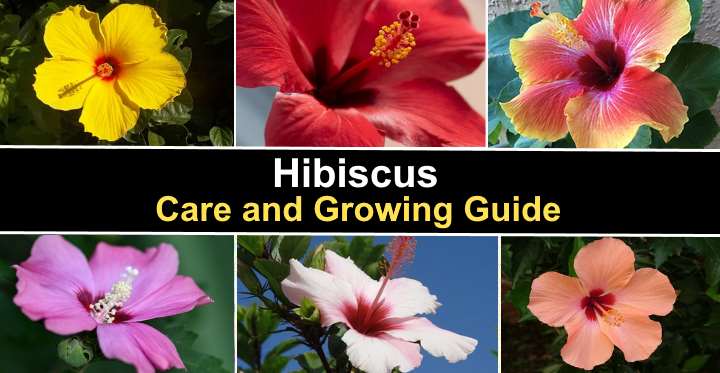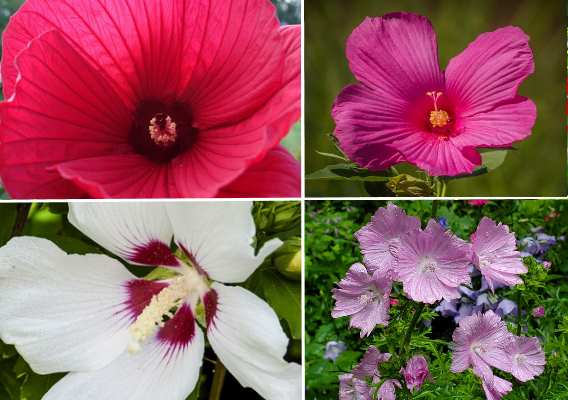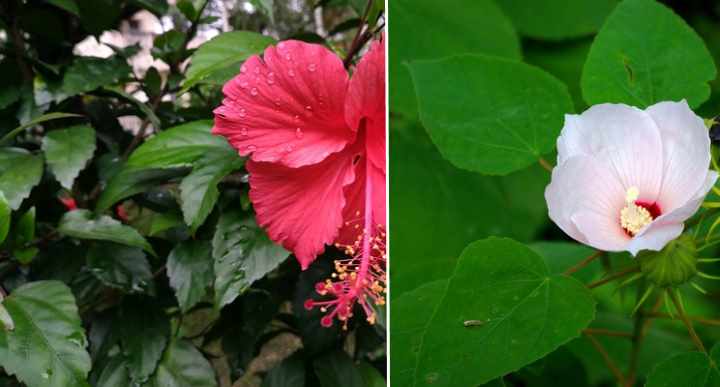Hibiscus: The Complete Care and Growing Guide

Hibiscus is a genus of large shrubs or small trees famous for their large, showy trumpet-shaped flowers. Hibiscus flowers have papery petals in hues such as pink, white, red, orange, yellow, purple, or peach. Growing hibiscus shrubs or trees in your front or backyard adds wonderful summer tropical flowers to your garden landscape.
The hibiscus plant genus is divided into two main categories—tropical hibiscus and hardy hibiscus. Tropical hibiscus plants include the Hibiscus rosa-sinensis cultivars. Hardy hibiscus plants for colder climates are Hibiscus moscheutos and Hibiscus syriacus, or rose of Sharon.
How to Care for Hibiscus
To care for Hibiscus, grow the shrubby plants in full sun or partial shade. Water the hibiscus regularly during warm weather when the plant is in bloom. Hibiscus plants are heavy feeders, so fertilize the plant regularly to encourage blooming. In winter, tropical and hardy hibiscus require less water and no fertilizing.
Hibiscus Flowers

Tropical hibiscus flowers come in a wide variety of colors and can be single or double blooms
Hibiscus is a group of perennial flowering plants with large, vibrantly colored flowers. Hibiscus flowers grow in a trumpet shape and can measure up to 12” (30 cm) across. The delicate papery-crepe petals form a star shape or saucer shape. The flowers usually have a long stamen protruding from the center.

Hardy hibiscus flowers are single blooms in colors of white, pink or red and can be very large
Deadheading hibiscus flowers is not necessary. However, snipping off fading blooms can help to improve the hibiscus shrub’s appearance. Removing dead hibiscus flowers also prevents reseeding and concentrates growth into the lush foliage and flowers. The same care advice for deadheading hibiscus is suitable for tropical and hardy species of hibiscus.
Hardy Hibiscus Vs. Tropical Hibiscus
Hardy hibiscus plants are easier to grow in temperate climates than the tropical varieties. Tropical hibiscus plants won’t grow in USDA zones lower than 9. However, with some protection, hardy hibiscus will survive freezing temperatures in USDA zones 5 through 8.
A hardy hibiscus plant will withstand winters when the temperature drops below zero. Usually, shrubs lose their blooms in late fall and early winter. In colder regions, the shrub will die back to the ground and regrow in the spring. In this case, cut back the stems to a few inches high in late fall, and you will see new growth come out when the weather warms again.
Tropical hibiscus flowers come in a wide variety of colors such as pink, white, red, orange, yellow, or peach and can be single or double blooms. However hardy hibiscus flowers are single blooms only in colors of white, pink or red and can be very large up to 12” (30 cm) wide.
Another difference between hardy hibiscus and tropical hibiscus plants is their leaves. Tropical hibiscus plants tend to have darker glossier green leaves, whereas hardy hibiscus leaves are duller green and are usually heart-shaped.

Leaves of tropical hibiscus (left) vs. leaves of hardy hibiscus (right)
Hibiscus Care
Hibiscus shrubs are generally easy to care for if you’re in the right zone. The bushy shrubs bloom with vibrantly-colored flowers if you water them enough and provide enough fertilizer. If you care properly for hibiscus, you will have flowers all summer long—all the way from midsummer through fall.
Some care aspects differ between hardy and tropical hibiscus. However, there are many similar care factors when growing these beautiful landscaping plants.
Temperature for Growing Hibiscus
Hardy hibiscus plants such as Hibiscus moscheutos and rose of Sharon (Hibiscus syriacus) thrive in USDA zones 5 through 8. These perennial shrubs can withstand freezing temperatures as low as -20°F (-29°C). The hibiscus plant will die back in freezing temperatures and will grow back in spring.
Hardy hibiscus shrubs need protection from heavy frost during winter. After cutting the dead stems, cover the root ball with plenty of mulch. This will help to protect the roots ready for them to regrow in the springtime.
When winter temperature is cold but not freezing, cover the hibiscus canopy to protect it from the cold weather.
Evergreen tropical hibiscus such as the Chinese hibiscus (Hibiscus rosa-sinensis) doesn’t grow outdoors in USDA zones lower than 9. If average temperatures drop to between 40°F and 50°F (4°C – 10°C), the plant may start losing its foliage. If outdoor temperatures drop below 20°F (-6°C), the tropical shrub will begin to die.
If you live in a temperate climate, you can grow tropical hibiscus plants in pots outdoors. However, when the average temperatures drop below 55°F (12°C), you should bring the potted plant indoors.
Hibiscus Plant Sun Requirements
Hibiscus grows best in full sun and will tolerate some shade. The best location for growing hibiscus is in a sunny place in your garden where it gets some protection from the intense midday sun. Hibiscus flowers grow best when the plant gets at least six hours of sunshine every day.
When deciding where to plant your hibiscus shrub, make sure it won’t be in too much shade. Shady growing conditions tend to slow the plant’s growth. You’ll also notice that hibiscus plants don’t bloom as much when they lack sufficient sunlight.
Both tropical and hardy hibiscus plants need protection from extremes in sunlight. Too much intense direct sunlight or growing in continual shade causes the hibiscus leaves to turn yellow. You may even notice white patches on the foliage. You may see that too much sun or too little light causes fewer buds to appear on the hibiscus.
If you live in hot, tropical climates, the best place to grow hibiscus is a partially shaded location. That way, your stunning flowering shrub won’t suffer damage from too much sunshine during summer.
The Best Hibiscus Soil
Hibiscus thrives in soil that is moist but never soggy or waterlogged. All hibiscus varieties—tropical, hardy, and potted plants—must grow in soil with excellent drainage. Ensure that the ground or potting mix has plenty of organic matter and is porous enough to allow excess water to drain away.
When growing hibiscus in your backyard, ensure the soil is slightly acidic. Hibiscus species grow best when the pH is between 6.5 and 6.8. If necessary, you can amend the soil with compost to increase acidity. Organic matter such as peat moss also locks in moisture—an essential care factor when growing hibiscus.
The best soil for growing hibiscus in containers should be a standard houseplant potting mix that is amended with perlite. The addition of perlite ensures that water drains through the growing medium freely. You can also amend the soil with peat moss to increase acidity and provide essential nutrients.
How to Water Hibiscus
The secret to getting plenty of flowers on a hibiscus plant is to water it well when it’s in bloom. Water hibiscus shrubs and trees daily in summer and warm fall days. When the weather is cooler, water less often to prevent soggy soil around the roots.
Generally, in winter, it’s best to let the ground partially dry before watering it.
If the weather is scorching, you’ll have to increase the watering frequency for tropical hibiscus plants. This can mean watering the flowering shrub as often as twice a day. However, if you notice that leaves start to turn yellow and drop, you might be watering too much.
When watering a tropical hibiscus indoors, follow the standard advice for watering houseplants. It would be best if you grow the hibiscus in bright, indirect sun and only water when the top 2” (5 cm) layer of soil is dry. Then, thoroughly drench the potting soil until water drains from the pot’s drainage hole.
How to Grow Hibiscus in Pots
Tropical hibiscus shrubs and small trees grow well in containers. As with hibiscus planted in the ground, the pot should be in a sunny location. Use a well-draining, organically-rich potting medium and water the potted hibiscus liberally in the summer and less often in winter. Always avoid letting the potting mix become soggy.
When growing tropical hibiscus indoors, don’t expose your hibiscus to dry air caused by heating, as it can cause bud drop, yellowing leaves and pest infestation. In this case, it is better to use a humidifier or humidity pebble tray to care for the hibiscus plant’s needs over the winter months.
To use a pebble tray to increase humidity levels, put some decorative pebbles in a shallow dish. Fill with water until half-way up the stones. Place the hibiscus pot on the pebbles, making sure the pot doesn’t sit in the water. Evaporation helps humidify the leaves. Top the tray up with water when necessary.
Transplanting Hibiscus Plants
Transplanting a hibiscus may be necessary if it outgrows its location in your garden. However, it’s vital to care for the tender bushy hibiscus shrub while transplanting it to prevent stress. To prepare a hibiscus shrub for replanting, it’s crucial to prepare the new hole and prune the hibiscus shrub.
To transplant a hibiscus, first dig a large enough hole in the new location. You may have to adjust the hole’s size, but getting the area ready will help reduce transplant shock. The new hole should be deep enough to accommodate the roots and about twice as wide.
The second step before digging the hibiscus from the ground is to prune it. Ideally, it would help if you reduced the hibiscus shrub size by about one-third. Transplanting a smaller hibiscus also reduces stress and helps the shrub to establish itself in the new location.
The best time to transplant a hibiscus is in the fall after the shrub has finished blooming.
Here is how to transplant a hibiscus shrub or small tree: Dig around the hibiscus shrub at a diameter of 1 ft. (30 cm) for every inch (2.5 cm) of trunk diameter. Dig under the roots and remove the plant from the ground. Gently move the hibiscus shrub to its new location.
When planting hibiscus in the hole, ensure that the soil line on the trunk measures up to the soil level. Fill the remainder of the space with the soil and pat down firmly to stabilize the shrub.
After transplanting hibiscus, water the ground thoroughly and keep the plant hydrated for the first four to six weeks. If there’s no rainfall, you’ll have to water the shrub every two or three days. After six weeks, put a layer of mulch over the hibiscus root zone to help lock in moisture and protect the roots from cold.
How to Prune Hibiscus
Pruning hibiscus trees and shrubs stimulates new buds and encourages plenty of flowers. Prune hibiscus in spring just before it starts growing vigorously. Cut hibiscus branches back about one-third and snip them off just above the node. You can also trim back any dead or diseased branches to improve the shrub’s appearance.
Apart from early spring, you can prune hibiscus plants in summer or early fall. However, pruning at this time doesn’t encourage as many flowers or growth. You should always avoid pruning hibiscus plants in late fall and winter. Hibiscus can be temperamental and don’t respond well to winter pruning.
Remember that hardy hibiscus plants may die back in late fall. You can trim back the branches to about 4” or 5” (10 – 13 cm) to prepare the plant for winter. The hibiscus should start growing again in spring when warmer days arrive. Usually, hardy hibiscus shrubs don’t start blooming until the end of May or the start of June.
Fertilizing Hibiscus
Tropical hibiscus requires more fertilization than hardy varieties. The best types of fertilizer for hibiscus in your backyard are balanced plant fertilizers for flowering plants. You can use a water-soluble or slow-release fertilizer. Fertilize every two weeks if using a water-soluble fertilizer and four times a year with a slow-release one.
When choosing the best fertilizer for flowering tropical hibiscus, choose a water-soluble one with a balanced NPK rating. Some examples are 20-20-20 or 10-10-10. This type of fertilizer ensures the shrub gets the nutrients it requires for robust growth and prolific blooming.
If using a slow-release fertilizer for tropical hibiscus shrubs, apply the granules in early spring, after the first flowers appear, mid-summer, and then early winter.
Hardy varieties of hibiscus plants typically grow well without additional fertilizer. You can apply a diluted general-purpose fertilizer two or three times during the growing season if you want to give the plant’s growth a boost.
Top care tip when fertilizing hibiscus shrubs: Always apply fertilizer to the whole root zone—approximately the canopy’s spread size.
Hibiscus Propagation
It’s easy to propagate hardy hibiscus and tropical hibiscus from cuttings. However, hardy hibiscus is more straightforward to propagate than the tropical varieties. Take a softwood cutting, approximately 6” (15 cm) long from a healthy hibiscus shrub. Strip the leaves off apart from the top ones. Place the cutting in an appropriate rooting mix.
Create a rooting mix for hibiscus plants by mixing equal parts of potting soil and perlite and putting it in a small pot. Make a hole in the soil and put the hibiscus cutting in. Firm the soil around the cutting and mist the soil.
To help the hibiscus cutting take root, place a plastic bag over the cutting and seal with an elastic band. Place the pot in partial shade and mist the soil every so often to keep the rooting soil moist. It could take about eight weeks to root. You can then transfer the new hibiscus plant to a bigger pot.
Use the same method to root tropical hibiscus plants. However, it would be best to put several stem cuttings in the rooting soil to increase your chance of taking root.
You can also propagate hibiscus from seeds. To germinate hibiscus seeds, make a small incision with a sharp knife in the seed. Soak overnight in water. Place the seeds on an appropriate soil mix and cover lightly with soil. It should take up to four weeks for seeds to sprout.
Be aware that some hibiscus varieties don’t produce seeds even under ideal conditions.
FAQ About Hibiscus Care
Although hibiscus is generally easy to care for, a few issues can affect its growth. Hibiscus, especially tropical hibiscus plants, is susceptible to changes in the environment. Let’s look in detail at some problems when growing hibiscus.
Why Are Hibiscus Flower Buds Dropping?
Several reasons can cause hibiscus buds and flowers to drop. A pest infestation, nutritional deficiencies, lack of water, temperature fluctuations, and over-fertilizing can result in buds or blooms dropping. To prevent flowers from falling, grow hibiscus trees and shrubs in plenty of sunlight, keep the soil moist, and ensure there’s adequate humidity.
What to Do About Bugs on Hibiscus Plants
Common garden pests that can affect hibiscus are aphids, thrips, whiteflies, scale, and mealybugs. To get rid of bugs from hibiscus plants, hose the hibiscus foliage with a strong jet of water. You could also make a natural neem oil pesticide and spray it on the leaves to stop pests from eating them.
Aphids, whiteflies, and mealybugs all suck the sap from hibiscus leaves and stems. To spot whiteflies on aphids on hibiscus, look for tiny pests crawling under leaves. Mealybugs will leave behind a white fuzzy substance like cotton wool.
Another type of pest control is to introduce beneficial insects to your garden. Ladybugs, lacewings, or hoverflies feed on garden pests and their larvae.
How to Get Rid of Fungus on Hibiscus Plants
Fungus on hibiscus looks like a white powdery substance called powdery mildew. Prune diseased foliage and branches and dispose of them in the trash. You should also water the ground, not the leaves, to avoid fungal foliage problems.
If other plants are crowding out your hibiscus, you may have to transplant it so that more air circulates around the plant. This should help to ensure that too much moisture doesn’t accumulate in the foliage.
Fungus leaf problems rarely kill plants, but the white fungus looks unsightly on hibiscus and spoils the plant’s appearance. If the fungus infection spreads, it can slow down the plant’s growth.
Why Are Hibiscus Leaves Turning Yellow?
Hibiscus leaves turn yellow due to too much water, pests, a nutrient deficiency, excessive sun exposure, or hot temperatures. It’s crucial to find out which of these problems is causing yellow hibiscus leaves.
Only water hibiscus plants just enough to keep the soil moist. This watering technique helps keep the hibiscus growing healthy and prevent yellow leaves. In hot weather, water more frequently than in cooler weather.
If drainage or sun exposure is an issue, you may have to transplant the shrub to keep it flowering and the foliage lush green.
Also, check for signs of spider mites on houseplant hibiscus and garden hibiscus. You can use a neem oil solution to get rid of these plant-sucking mites.
If you suspect a nutrient deficiency, use a diluted balanced fertilizer every two weeks to improve the leaves’ appearance and encourage healthy hibiscus growth.
Discover the most beautiful types of hibiscus.
Related articles:
- Rose of Sharon (Hibiscus Syriacus): Care & Varieties
- Small or Dwarf Flowering Shrubs
- 21 Evergreen Shrubs for Front or Backyard
